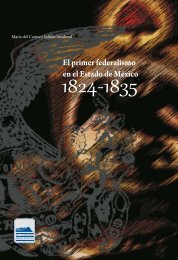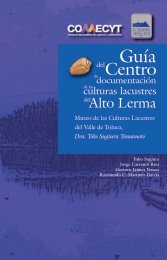Korpus 21 - Vol. 3
Korpus 21 - Nuevas interpretaciones acerca de la consumación de la Independencia.
Korpus 21 - Nuevas interpretaciones acerca de la consumación de la Independencia.
Create successful ePaper yourself
Turn your PDF publications into a flip-book with our unique Google optimized e-Paper software.
JOHN TUTINO, 18<strong>21</strong>: THE END OF NEW SPAIN, DREAMS OF AN IMPOSSIBLE MEXICO<br />
The Bajío prospered thanks to the dynamism<br />
of silver, strong from 1590 to 1640,<br />
steady to 1700, booming through the eighteenth<br />
century. Its producing majority lived<br />
in dependence in a commercial world, sustained<br />
in modest prosperity by their own<br />
scarcity relative to the rising demands of a<br />
profitable silver capitalism. They gained solid<br />
pay, maize rations, and land rentals for<br />
centuries –until population growth turned<br />
against them and they faced new more predatory<br />
impositions after 1780 (with limited<br />
access to judicial mediations). Still, production<br />
boomed and stability held to 1810 (Tutino,<br />
2011).<br />
North of the Bajío, silver mining remained<br />
the engine of Spanish North America: Zacatecas<br />
and San Luis Potosí to 1640, Parral<br />
1640 to 1700, Santa Eulalia near Chihuahua<br />
after 1700 –joined by revivals at Zacatecas<br />
and San Luis Potosí and new booms at Bolaños,<br />
Catorce, Sombrerete, and more. Regions<br />
north of the Bajío also saw most original<br />
state-free peoples eliminated after 1550<br />
by disease and long conflicts, pressured to<br />
settle in missions in marginal uplands (without<br />
rights to land and self-rule). With the<br />
dearth of local native peoples, the north,<br />
too, was settled by migrants from Mesoamerica<br />
along with enslaved Africans, who<br />
again amalgamated to generate growing<br />
populations of free mulattoes who worked<br />
in mines and grazing estates. With the plateau<br />
north of the Bajío mostly dry, cultivation<br />
was limited, except at irrigable oases<br />
such as Aguascalientes, which fed Zacatecas.<br />
The north did not develop major textile<br />
centers –its herds of sheep supplying wool<br />
to Bajío obrajes. Thus, while mining, immigrant<br />
populations, and thoroughly commercial<br />
ways characterized all of Spanish North<br />
America, the Bajío developed commercial<br />
cultivation and textile manufacturing to sustain<br />
itself and regions north –leaving the latter<br />
dependent on the Bajío as profit seekers<br />
drove deeper into the continent. Stability<br />
held in the north, as there too, population<br />
scarcity led to ample and secure remunerations<br />
–a situation that endured to 1810 and<br />
long after (Bakewell, 1971; Hadley, 1979; Langue,<br />
1979; Martin, 1996; Tutino, 2011).<br />
Mexico City integrated Spanish Mesoamerica,<br />
Spanish North America, and the larger<br />
silver capitalism that reached across the<br />
globe to energized everything. Judicial institutions<br />
in the capital oversaw the mediating<br />
justice that kept peace and social stability<br />
across Spanish Mesoamerica, in the regions<br />
of dynamic silver capitalism near the capital<br />
and across zones of indigenous primacy<br />
stretching south. Financial and commercial<br />
powers concentrated there, funded mines in<br />
the Mesoamerican heartland, the Bajío, and<br />
across the north. The capital’s merchant financiers<br />
ruled Atlantic and Pacific trades<br />
(Brading, 1973; Yuste, 2013), sending silver<br />
to fuel economies from Europe, through the<br />
Middle East to South Asia, and via Manila to<br />
China, too –where nearly all the silver eventually<br />
landed to fuel the world most dynamic<br />
economy (Pomeranz, 2000; Parthasarathi,<br />
2011). The financial/commercial and administrative/judicial<br />
powers set in the capital<br />
made New Spain an integrated, prosperous,<br />
stable, and powerful kingdom, funded by<br />
locally generated capital –linking diverse<br />
ways of production, community, and culture<br />
to fund Spain’s empire and fuel global trades<br />
(Tutino, 2018b). A globally-linked silver<br />
capitalism –not mining alone– defined New<br />
Spain and its dynamism in the Americas and<br />
the world.<br />
During the eighteenth century, global trade<br />
expansion, imperial rivalries, rising revenue<br />
demand, and population growth merged<br />
to create new pressures and deepening<br />
inequities in New Spain. Still, silver capitalism<br />
boomed and stability held. When population<br />
growth created new pressures on resources<br />
in indigenous republics, then mixed with rising<br />
land disputes and new commercial intrusions,<br />
judicial mediations held the social<br />
peace across Spanish Mesoamerica –in regions<br />
of dynamic silver capitalism near the<br />
capital, and in Oaxaca, too, far from its profits<br />
and pressures (Taylor, 1979).<br />
The Seven Years War of 1757-63 brought<br />
Spain claims to the lands west of the Mississippi<br />
from New Orleans to St. Louis, thus most<br />
334


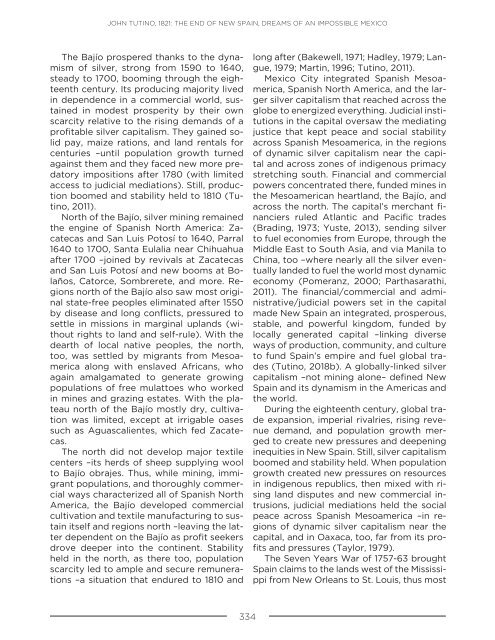
![bicentenario_1[V2]](https://img.yumpu.com/68677971/1/167x260/bicentenario-1v2.jpg?quality=85)
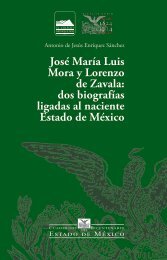
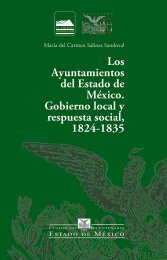

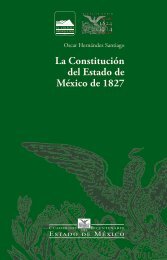
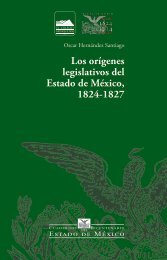
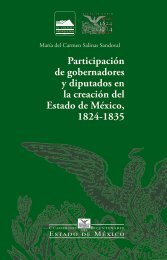
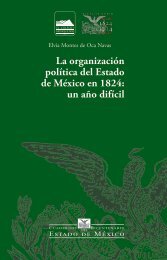
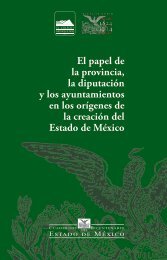

![El_primer_federalismoEM[final]_compressed (2)](https://img.yumpu.com/68483279/1/178x260/el-primer-federalismoemfinal-compressed-2.jpg?quality=85)
